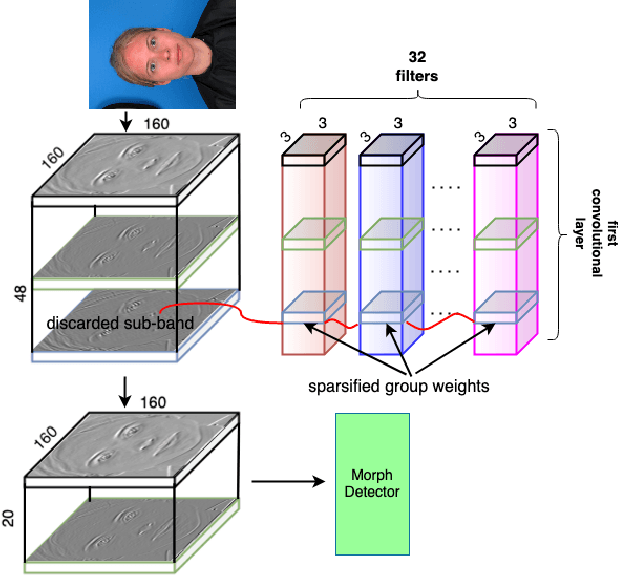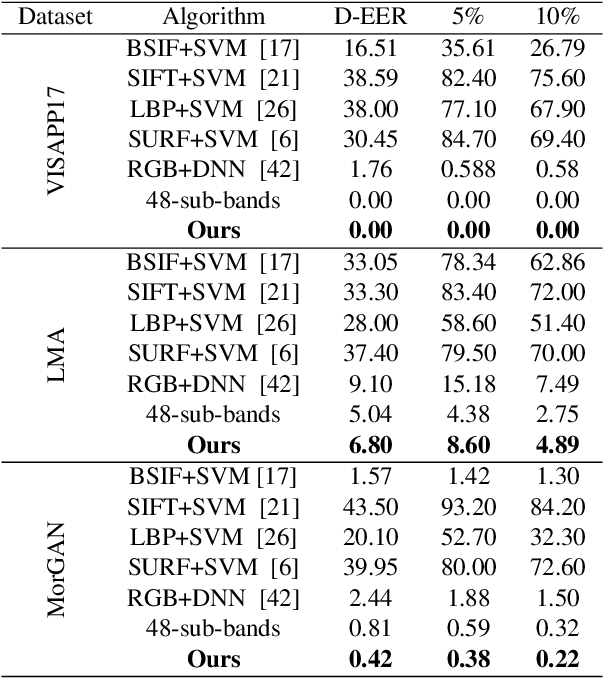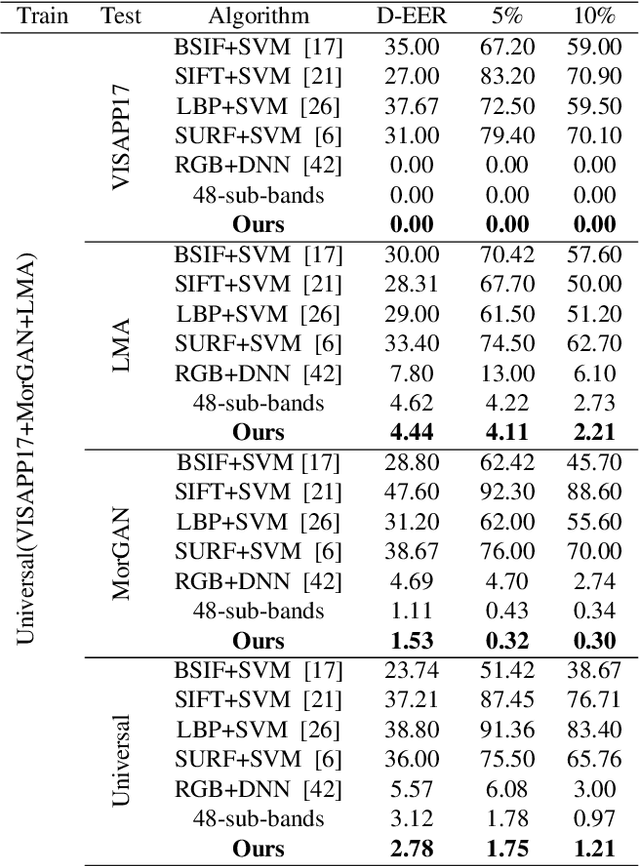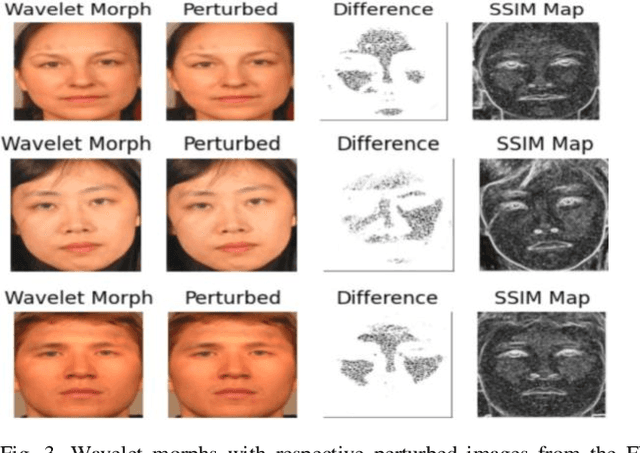Poorya Aghdaie
Morph Detection Enhanced by Structured Group Sparsity
Nov 29, 2021



Abstract:In this paper, we consider the challenge of face morphing attacks, which substantially undermine the integrity of face recognition systems such as those adopted for use in border protection agencies. Morph detection can be formulated as extracting fine-grained representations, where local discriminative features are harnessed for learning a hypothesis. To acquire discriminative features at different granularity as well as a decoupled spectral information, we leverage wavelet domain analysis to gain insight into the spatial-frequency content of a morphed face. As such, instead of using images in the RGB domain, we decompose every image into its wavelet sub-bands using 2D wavelet decomposition and a deep supervised feature selection scheme is employed to find the most discriminative wavelet sub-bands of input images. To this end, we train a Deep Neural Network (DNN) morph detector using the decomposed wavelet sub-bands of the morphed and bona fide images. In the training phase, our structured group sparsity-constrained DNN picks the most discriminative wavelet sub-bands out of all the sub-bands, with which we retrain our DNN, resulting in a precise detection of morphed images when inference is achieved on a probe image. The efficacy of our deep morph detector which is enhanced by structured group lasso is validated through experiments on three facial morph image databases, i.e., VISAPP17, LMA, and MorGAN.
Adversarially Perturbed Wavelet-based Morphed Face Generation
Nov 03, 2021



Abstract:Morphing is the process of combining two or more subjects in an image in order to create a new identity which contains features of both individuals. Morphed images can fool Facial Recognition Systems (FRS) into falsely accepting multiple people, leading to failures in national security. As morphed image synthesis becomes easier, it is vital to expand the research community's available data to help combat this dilemma. In this paper, we explore combination of two methods for morphed image generation, those of geometric transformation (warping and blending to create morphed images) and photometric perturbation. We leverage both methods to generate high-quality adversarially perturbed morphs from the FERET, FRGC, and FRLL datasets. The final images retain high similarity to both input subjects while resulting in minimal artifacts in the visual domain. Images are synthesized by fusing the wavelet sub-bands from the two look-alike subjects, and then adversarially perturbed to create highly convincing imagery to deceive both humans and deep morph detectors.
Attention Aware Wavelet-based Detection of Morphed Face Images
Jul 22, 2021



Abstract:Morphed images have exploited loopholes in the face recognition checkpoints, e.g., Credential Authentication Technology (CAT), used by Transportation Security Administration (TSA), which is a non-trivial security concern. To overcome the risks incurred due to morphed presentations, we propose a wavelet-based morph detection methodology which adopts an end-to-end trainable soft attention mechanism . Our attention-based deep neural network (DNN) focuses on the salient Regions of Interest (ROI) which have the most spatial support for morph detector decision function, i.e, morph class binary softmax output. A retrospective of morph synthesizing procedure aids us to speculate the ROI as regions around facial landmarks , particularly for the case of landmark-based morphing techniques. Moreover, our attention-based DNN is adapted to the wavelet space, where inputs of the network are coarse-to-fine spectral representations, 48 stacked wavelet sub-bands to be exact. We evaluate performance of the proposed framework using three datasets, VISAPP17, LMA, and MorGAN. In addition, as attention maps can be a robust indicator whether a probe image under investigation is genuine or counterfeit, we analyze the estimated attention maps for both a bona fide image and its corresponding morphed image. Finally, we present an ablation study on the efficacy of utilizing attention mechanism for the sake of morph detection.
Differential Morph Face Detection using Discriminative Wavelet Sub-bands
Jun 24, 2021



Abstract:Face recognition systems are extremely vulnerable to morphing attacks, in which a morphed facial reference image can be successfully verified as two or more distinct identities. In this paper, we propose a morph attack detection algorithm that leverages an undecimated 2D Discrete Wavelet Transform (DWT) for identifying morphed face images. The core of our framework is that artifacts resulting from the morphing process that are not discernible in the image domain can be more easily identified in the spatial frequency domain. A discriminative wavelet sub-band can accentuate the disparity between a real and a morphed image. To this end, multi-level DWT is applied to all images, yielding 48 mid and high-frequency sub-bands each. The entropy distributions for each sub-band are calculated separately for both bona fide and morph images. For some of the sub-bands, there is a marked difference between the entropy of the sub-band in a bona fide image and the identical sub-band's entropy in a morphed image. Consequently, we employ Kullback-Liebler Divergence (KLD) to exploit these differences and isolate the sub-bands that are the most discriminative. We measure how discriminative a sub-band is by its KLD value and the 22 sub-bands with the highest KLD values are chosen for network training. Then, we train a deep Siamese neural network using these 22 selected sub-bands for differential morph attack detection. We examine the efficacy of discriminative wavelet sub-bands for morph attack detection and show that a deep neural network trained on these sub-bands can accurately identify morph imagery.
* CVPR Biometrics Workshop 2021
Detection of Morphed Face Images Using Discriminative Wavelet Sub-bands
Jun 16, 2021



Abstract:This work investigates the well-known problem of morphing attacks, which has drawn considerable attention in the biometrics community. Morphed images have exposed face recognition systems' susceptibility to false acceptance, resulting in dire consequences, especially for national security applications. To detect morphing attacks, we propose a method which is based on a discriminative 2D Discrete Wavelet Transform (2D-DWT). A discriminative wavelet sub-band can highlight inconsistencies between a real and a morphed image. We observe that there is a salient discrepancy between the entropy of a given sub-band in a bona fide image, and the same sub-band's entropy in a morphed sample. Considering this dissimilarity between these two entropy values, we find the Kullback-Leibler divergence between the two distributions, namely the entropy of the bona fide and the corresponding morphed images. The most discriminative wavelet sub-bands are those with the highest corresponding KL-divergence values. Accordingly, 22 sub-bands are selected as the most discriminative ones in terms of morph detection. We show that a Deep Neural Network (DNN) trained on the 22 discriminative sub-bands can detect morphed samples precisely. Most importantly, the effectiveness of our algorithm is validated through experiments on three datasets: VISAPP17, LMA, and MorGAN. We also performed an ablation study on the sub-band selection.
 Add to Chrome
Add to Chrome Add to Firefox
Add to Firefox Add to Edge
Add to Edge